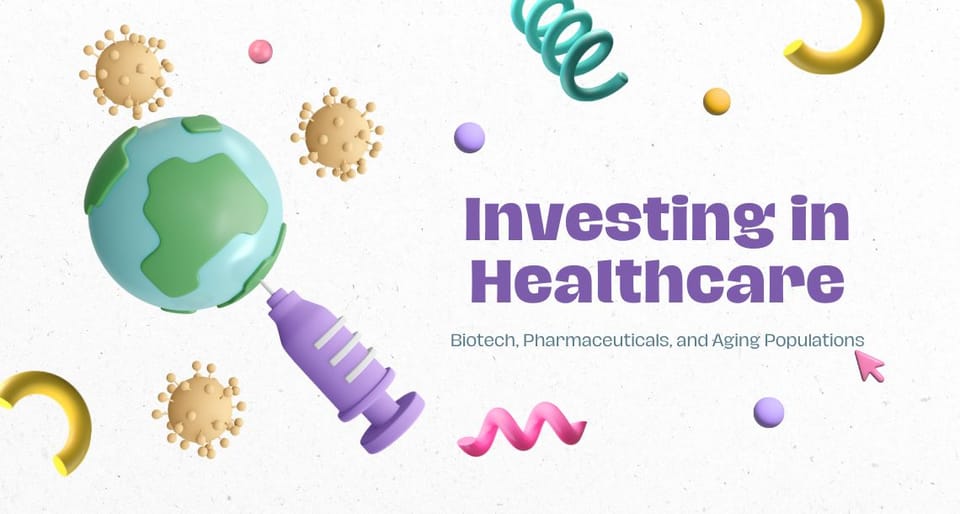The Long-Term Case for Investing in Healthcare: Biotech, Pharmaceuticals, and Aging Populations

Healthcare has always been an essential part of human society, but in recent years, it has transformed into one of the most promising and robust sectors for long-term investment. With groundbreaking advances in biotechnology, pharmaceuticals, and a rapidly aging population, the healthcare industry presents a range of opportunities for investors who are looking to ride the wave of innovation while also benefiting from demographic shifts.
Let’s dive into why healthcare is not just a defensive sector for uncertain times, but a powerhouse of growth that will only continue to expand as we move further into the 21st century. The convergence of biotech breakthroughs, pharmaceutical innovations, and the aging global population creates a perfect storm for investors seeking sustainable long-term returns.
1. Biotech: The Heartbeat of Tomorrow’s Medicine
When we talk about healthcare, biotech is the sector that truly represents the future. The biotech industry is advancing at a breakneck pace, developing gene therapies, personalized medicine, and cancer immunotherapies that were once considered science fiction. These innovations not only have the potential to revolutionize how we treat diseases, but they also open doors to a market that could be worth trillions of dollars in the coming decades.
Consider the case of CRISPR-Cas9, a gene-editing technology that has made it possible to “cut and paste” DNA to eliminate genetic diseases. Companies involved in gene-editing, such as Editas Medicine and Intellia Therapeutics, are at the forefront of a movement that could cure previously untreatable diseases. These advancements offer investors a glimpse into the future of medicine—one where genetic modifications could vastly improve human health, reduce disease burden, and even extend life expectancy.
Another area driving biotech growth is immunotherapy, especially in cancer treatments. For instance, CAR-T cell therapies have shown remarkable success in treating blood cancers like leukemia and lymphoma. As more biotech companies develop and refine these treatments, the market for immune-oncology could explode, potentially worth over $100 billion by 2030.
2. Pharmaceuticals: A Sector That Never Goes Out of Style
While biotech may seem like the flashier, more futuristic part of healthcare, pharmaceuticals remains the steady backbone of the industry. In fact, the pharmaceutical sector is home to some of the most reliable long-term investments available. The global pharmaceutical market is expected to reach $1.8 trillion by 2025, with major players like Pfizer, Johnson & Johnson, and Merck leading the charge.
Why is the pharmaceutical industry such a safe bet for long-term investors?
- Growing Demand: As the global population continues to age, the demand for drugs to treat chronic conditions like heart disease, diabetes, and arthritis will only increase. Pharmaceuticals are essential in managing these diseases, and as more people live longer lives, the need for medication grows exponentially.
- Innovation Pipeline: Pharmaceutical companies invest heavily in research and development (R&D) to create new, life-saving drugs. Whether it’s creating vaccines (like the groundbreaking COVID-19 vaccines from Pfizer and Moderna) or targeting rare diseases with precision medicines, the pharmaceutical sector is constantly evolving. Even with patent expirations and generic drugs coming into play, the demand for newer and better treatments keeps the sector thriving.
- Stable Revenue Stream: Pharmaceuticals have long been known for offering investors steady returns. Companies like Gilead Sciences and AbbVie generate billions of dollars in revenue from established products like HIV treatments and immune-suppressive drugs. These companies are also constantly expanding their portfolios through acquisitions and R&D to diversify and future-proof their earnings.
3. Aging Populations: The Silver Tsunami
One of the most significant long-term trends shaping the future of healthcare—and, by extension, investment opportunities—is the aging of the global population. This demographic shift, often referred to as the "silver tsunami," is creating an immense demand for healthcare services, drugs, and treatments designed to improve quality of life in old age.
The numbers are staggering:
- By 2050, there will be an estimated 2.1 billion people aged 60 or older, more than double the number of senior citizens today. The global elderly population is expected to grow from 13% in 2019 to 22% by 2050.
- This aging population will experience higher incidences of age-related diseases like Alzheimer's, Parkinson’s, cancer, and heart disease, which require long-term care and ongoing medical treatments.
This is where long-term investors should take note. The healthcare industry will need to expand exponentially to support this aging cohort. Companies involved in geriatrics, long-term care facilities, home healthcare, and assistive technologies will benefit greatly as demand surges.
Pharmaceuticals that focus on age-related diseases, like biologics and anti-aging therapies, are likely to see skyrocketing sales. For example, Alzheimer's treatments are still in early stages, but breakthroughs could generate massive market opportunities. Even treatments for osteoporosis and muscular degeneration will see greater demand as people live longer.
4. The Rise of Telemedicine and Digital Health: A New Frontier
Telemedicine and digital health technologies are also accelerating the growth of the healthcare sector. The pandemic made it abundantly clear that the future of healthcare is moving online. Companies offering telehealth services, wearable health devices, and AI-based diagnostic tools have seen explosive growth, and this trend is not likely to slow down.
The global telemedicine market is projected to grow at a compound annual growth rate (CAGR) of 25.8% from 2021 to 2028. This is good news for investors looking at the long-term potential of digital health companies. With AI-powered health monitoring, remote patient management, and virtual consultations, healthcare delivery is becoming more efficient, affordable, and accessible.
5. Long-Term Investment Strategy: The Case for Healthcare
Investing in healthcare is not about riding the wave of the latest trend—it's about understanding that healthcare is an evergreen industry that will continue to thrive regardless of broader economic conditions. As long as people live longer, the demand for healthcare will only grow. Biotech innovations, the global rise in chronic diseases, and the aging population all contribute to making healthcare one of the most promising long-term investment sectors.
In addition to being a stable investment, healthcare offers investors the unique opportunity to be part of something truly transformative. Whether it’s discovering cures for previously untreatable diseases or helping people live longer, healthier lives, the healthcare industry offers the chance to invest in both financial growth and positive societal impact.
The Future of Healthcare Investment
As we look toward the future, healthcare offers unparalleled growth opportunities driven by biotech innovation, the aging population, and medical advancements. For long-term investors, the healthcare sector is not only a smart financial move but also an opportunity to be a part of something truly life-changing.
So, as the global healthcare landscape continues to evolve, keep an eye on this sector. Whether through biotech breakthroughs, pharmaceutical giants, or the long-term trends of aging and chronic disease, the healthcare industry is where the future of both investing and human progress collide. And for those with the foresight to invest, it promises to be a rewarding ride.






Member discussion